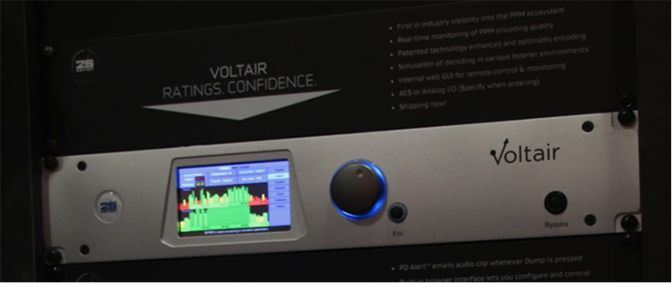
One of the most notable technology issues in the radio industry recently regards the consistency in performance of Nielsen Audio’s (formerly Arbitron’s) Personal People Meter (PPM) TM audience ratings system across various radio formats and/or different listening environments. Broadcasters have lodged complaints about the PPM’s accuracy in these respects almost since its introduction in 2007, but more recently the concerns have been taken to a new level, even finding their way to Congressional hearings in 2009, and continuing industry discussions.
At the 2015 NAB Show, Dr. Barry Blesser, director of research for The Telos Alliance, and co-founder of one of its subsidiaries, 25-Seven Systems, delivered a paper entitled “Monitoring for Ratings: Putting Yourself in Your Listeners’ Ears.” It considered some of the reasons why the audio watermarking and perceptual masking techniques used by the PPM system might perform differently based on the format of the radio service involved, or the ambient sound conditions surrounding the PPM. It should be noted that Dr. Blesser/25-Seven Systems also promoted a product at the Show that addresses these issues, which is described below.
In his paper, Blesser first reviewed the structure of the PPM’s watermarking signals, explaining the system’s use of frequency-shift keyed (FSK) tone-bursts within five different bands, at varying amplitudes within the audio band, which are utilized in conjunction with perceptual masking analysis (similar to that used by digital audio codecs in data-compression systems) employed to keep the watermark tones essentially inaudible.

He then cited the problem that the optimum length of a given watermark tone burst, say 600 ms, may not be possible to include in its entirety under the masking threshold, and so the tone burst might therefore be truncated by the masking system. While the precise length of the FSK tone burst is not critical to the encoded data, the shorter the burst, the lower the likelihood of proper detection. This problem is exacerbated if the acoustical environment in which the PPM hears the broadcast includes high levels of background noise.
Opportunities for the FSK tones to be masked are plentiful under certain program conditions, such as popular music formats, but they are less available in conditions where speech is predominant, such as news/talk formats.
Blesser presented numerous spectrographs illustrating the problem, and concluded his paper presentation with a brief reference to the new product formally introduced at the Show by 25-Seven Systems called the Voltair, which monitors the level of the PPM watermark over time on the device’s high-resolution display.
The manufacturer claims that the Voltair device can also potentially increase the likelihood of watermark detection by PPMs under difficult audio program or ambient noise conditions, via the application of proprietary audio processing. Based on the company’s substantial research, the Voltair unit re-evaluates the masking characteristics of the current audio program (relative to the PPM encoder’s original masking assessments), and allows the broadcaster to adjust the relative level of the previously embedded watermark within the recalculated mask. A 0-24 range setting is provided, and the manufacturer suggests that users start with a setting of 6, and experiment from there.
As with any aural watermark, the two parameters to be balanced are audibility and robustness, with Voltair giving the broadcaster a wide range of choices within this spectrum. The manufacturer recommends placing the Voltair device after the station’s audio processor and before the stereo generator, or more ideally, between compression and final limiting in the audio processing chain (where some single-box audio processors may provide an insertion point).
The device includes a General Purpose Input/Output (GPIO) control interface, which can be used to toggle the device’s operation across two or three different stored settings. One application of this feature suggested by the manufacturer is programming it to change the setting on a frequent, regular basis across a rating period (e.g., setting the control to level 10 on even minutes and level 12 for odd minutes, which would provide an average of level 11 over a quarter-hour), which could have the effect of reducing the impact of environmental variables, compared to using a single setting throughout the period. Toggling between three settings could purportedly provide even more reliable results and predictions. This could provide a broadcaster with a simple method of running its own automated and logged optimization experiments or other statistical exercises during ratings periods, and evaluating the ratings results from those periods when they are subsequently received from Nielsen.
The Telos Alliance has established a research department devoted to general watermarking technology—a rapidly expanding field—so it is implied that future devices (or even field upgrades to existing devices) may address aural watermark systems beyond the Nielsen PPM.
Dr. Blesser’s full presentation is available online at NAB Show Playback, as part of the Playback Select 2015: Broadcast Engineering Conference package.

